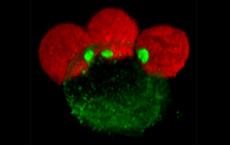Researchers find new clues about how HIV reservoirs may form
19 Aug 2011
Much like cities organise contingency plans and supplies for emergencies, chronic infectious diseases like HIV form reservoirs that ensure their survival in adverse conditions. But these reservoirs - small populations of viruses or bacteria of a specific type that persist despite attack by the immune system or drug treatment - are not always well understood.
 |
| Cell-to-cell transmission: An infected donor cell, outlined by the green fluorescent HIV it contains, transmits HIV to uninfected target cells (in red). Credit: Benjamin K. Chen, Mount Sinai School of Medicine |
Now, however, researchers at the California Institute of Technology (Caltech) believe they have begun to decode how a reservoir of infection can persist in HIV-positive populations.
The research team - led by David Baltimore, Robert Andrews Millikan Professor of Biology and recipient of the 1975 Nobel Prize in physiology or medicine - proposes that a type of HIV infection that uses infected cells to get close to uninfected cells and then discharge a large load of virus on them, may be the reason small populations of HIV-infected cells persist even when antiretroviral drug treatment has been successful in suppressing most other infections within an individual.
Their findings were reported in the advance online publication of the journal Nature on 17August.
For chronic infections such as HIV, the end game for scientists is to remove "chronic" from the disease's name - by finding a cure. Many believe that better understanding of viral reservoirs may be the key to eradicating them, and thus the disease. So the research team started at the beginning of the process, looking for clues into how an HIV reservoir might be formed in the first place.
There are two known ways that HIV can infect cells, and thus the human body: cell-free transmission, in which the virus infects immune system cells called T cells it encounters while floating free in plasma; and cell-to-cell transmission, in which the virus moves between T cells by using an infected ''donor'' cell as its vehicle.






























